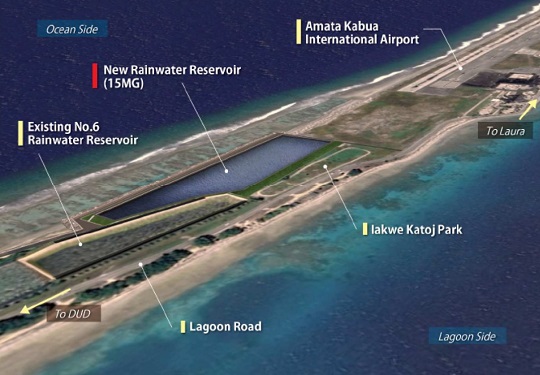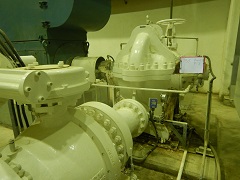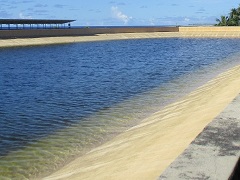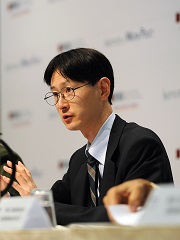[June is Environment Month in Japan] Tackling climate change’s impact on water (Part Two): Measures in developing countries - the keyword is “Co-Benefits Approach”!
2021.06.28
In the second part of this series on JICA’s efforts to combat climate change in the water resources sector, MATSUMOTO Shigeyuki, group director of the Water Resources Group, Global Environment Department, speaks about what specific actions JICA is taking.

Conceptual drawing of the Majuro Reservoir being developed in the Marshall Islands, an island nation in Oceania. A gigantic reservoir will be constructed to store rainfall that falls on the airport runway
- We hear that there are two approaches to combating climate change; "mitigation measures" and "adaptation measures." What kind of measures are they?
Matsumoto: “Mitigation measures” aim to reduce or absorb greenhouse gas emissions such as carbon dioxide and methane. “Adaptation measures” aim to prevent or reduce the damage caused by climate change that already exists. In the water sector, the electricity consumption of motors and pumps in water systems is substantial, and reducing such energy consumption is one of the mitigation measures. On the other hand, building reservoirs to prepare for droughts, reducing leakage from water pipes, and preparing for floods are adaptation measures.
- Tell us about these two measures that JICA is currently pursuing in the water resources sector.
Matsumoto: A recent example of mitigation measures is the Project for Improvement of Water Supply System to Greater Amman in Jordan. Jordan is one of the countries with the fewest water resources in the world, and the plan is to improve the aging facilities of the Zai Water Supply System built in 1985. The project aims to contribute to the stable supply of water to the capital city of Amman, and to climate change mitigation measures. This will be achieved by preventing the loss of water supply due to malfunctions, improving energy efficiency, and reducing operating costs.
Since the Zai Water Supply System pumps water over an elevation difference of approximately 1,260 meters, the amount of electricity and the cost of the system constitute a significant burden. The project is expected to reduce greenhouse gas emissions by around 6.97 million tons of CO2 equivalent per year by reducing electricity consumption through the replacement of equipment. Since the average household in Japan emits about 2.8 tons of CO2 per year, this project is expected to reduce the CO2 emissions of the equivalent of about 2.5 million Japanese households.

A giant pump used in Jordan’s Zai Water Supply System. These pumps will be replaced to improve energy efficiency and reduce greenhouse gas emissions

The existing reservoir in Majuro. Preparing for drought by building more reservoirs like this one
Also, in terms of adaptation measures, the Marshall Islands is about to begin the Project for Improvement of Water Reservoir at Majuro Atoll. It is to develop a reservoir with a capacity of 57,000 m³ as a lifeline to prepare for droughts caused by changes in rainfall patterns due to future climate change. If we assume that a standard 25-meter swimming pool has a capacity of 400 m³, this represents a little less than 143 of such pools or the equivalent of 19 days' worth of water for the 28,000 people living in Majuro. There is already a reservoir of 100,000 m³, which is enough for about 55 days, so when the project is completed, it will be able to supply water for roughly 74 days in total.
- What are some of the challenges that you face as you promote climate change countermeasures in developing countries?
Matsumoto: The challenge is about achieving a balance between sustainable development and climate change countermeasures. For example, plant-derived biofuels to replace fossil fuels have high expectations as a measure to combat climate change. However, a large amount of water is needed to grow the plants that will be used as materials. In other words, we may find ourselves in a situation where we have to make a trade-off between climate change and water issues. Also, although hydropower is a renewable energy source, it does not mean that we can just build a lot of dams. Consideration must be given to how to avoid or mitigate the negative effects of dam construction on the environment and society. As you can see, we have to examine the impact on the environment and society as we progress with our climate change countermeasures.
Many developing countries are faced with a variety of challenges such as reducing poverty, securing water and food supplies, and improving health care and education. With limited budgets, the fact remains that they are unable to adequately address the long-term effects of climate change.
For this reason, when dealing with these countries, it is necessary to cooperate with the goal of effectively balancing climate change action and sustainable development. This is what we call the “Co-BenefitsApproach.” By balancing effects of sustainable development and climate change countermeasures in developing countries, it aims to contribute to the realization of a resilient society against climate change and the transition to decarbonization. In addition to water resources, we will promote cooperation by combining elements of climate change countermeasures in the forest and environmental conservation, energy, transportation, flood prevention, and disaster management sectors.

MATSUMOTO Shigeyuki, group director of the Water Resources Group, Global Environment Department, explains JICA's policy of cooperation on climate change countermeasures in the water sector at an international seminar hosted by Institute of Water Policy, National University of Singapore
scroll